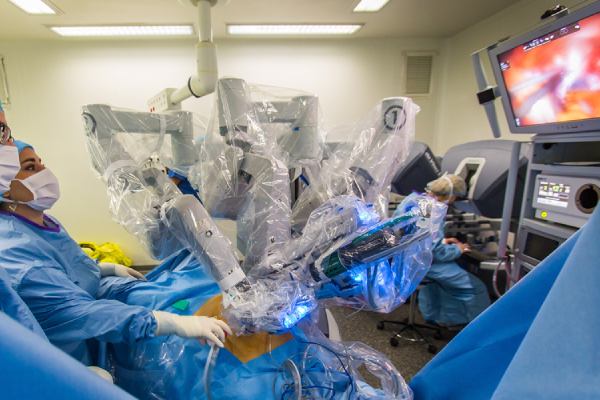
Recent years have seen the rise of robotic surgery as a game-changer in urology, especially for patients with kidney problems. Compared to conventional open surgery, this minimally invasive method has many advantages due to the precision and adaptability of robotic devices. Robotic kidney surgery is quickly replacing traditional methods as the gold standard in modern medicine. Its advantages include shorter recovery times, fewer complications, and better overall results.
Robotic kidney surgery
The da Vinci Surgical System is the most popular robotic system used in robotic kidney surgery. It helps surgeons conduct complex procedures more accurately and with more control. Surgeon seating, a cart with robotic arms for use at the patient’s side, and a high-definition, three-dimensional vision system make up this system. Through the use of a control panel, the surgeon is able to direct the robotic arms to employ micro-movements of surgical tools that are as exact as their hand movements.
Complex urological treatments, such as pyeloplasty (kidney obstruction repair surgery), radical nephrectomy (kidney removal in its entirety), and partial nephrectomy (specific kidney removal), benefit greatly from this technology. Robotic arms’ superior dexterity and range of motion make for painstaking dissection and suturing, which in turn improves surgical outcomes while decreasing the likelihood of problems.
The Benefits of Robotic Kidney Surgery
- A Method with Minimal Repercussions
The fact that robotic kidney surgery causes minimum disruption to the patient is one of its main selling points. Robotic surgery only requires a few tiny incisions, usually no more than 1 centimeter, in contrast to the huge incisions needed for conventional open surgery. fewer damage to the body, fewer blood loss, and less infection are the outcomes of this.
- Improved Accuracy and Management
The surgical field is shown to the surgeon in a magnified, high-definition 3D image by the robotic system, which offers depth perception and clarity that has never been seen before. Because of the delicate nature of the tissues that must be conserved during kidney surgery, this enables for more accurate movements and better control over the surgical tools.
- Reduced Time to Recovery
Recovery time for patients undergoing robotic kidney surgery is usually shorter than that of patients undergoing open surgery. A shorter hospital stay, fewer pain medication requirement, and less discomfort after surgery are all benefits of using smaller incisions. Instead of being out of commission for months after conventional surgery, most patients are able to get back to their regular routines after just a few weeks.
- Decreased Potential for Issues
Robotic surgery’s pinpoint accuracy lessens the possibility of problems including infection, bleeding, and harm to adjacent tissues. When it comes to kidney surgery, this is of the utmost importance so that healthy kidney tissue can be preserved. More nuanced and exact movements are possible with the robotic system’s improved dexterity and control, reducing the likelihood of unintentional harm to adjacent organs and blood arteries.
A Review of Robotic Kidney Surgery and Its Potential Uses
- Nephrectomy Lesions
To remove the tumor while keeping as much healthy kidney tissue as feasible, partial nephrectomy is frequently suggested in cases of tiny kidney tumors. Because of its pinpoint accuracy, robotic surgery is perfect for this operation; it lets the physician delicately remove the tumor without damaging the healthy kidney tissue around it. Preserving kidney function and lowering the future risk of chronic renal disease are both achieved by this technique.
- Nephrectomy for Cancer
A radical nephrectomy involves removing the entire kidney, which may be required for larger or more malignant kidney cancers. Minimized blood loss, decreased operating time, and expedited recovery are just a few of the many benefits of robotic surgery in this particular treatment. The robotic system’s superior vision and control make it possible to remove the kidney and its surrounding tissues with greater precision, which in turn lowers the likelihood of cancer returning.
- Pyeloplasty
In cases of ureteropelvic junction (UPJ) obstruction, a surgical treatment called pyeloplasty is employed to remove the obstruction at the point where the ureter connects to the kidney. Compared to open surgery, robotic-assisted pyeloplasty has better results, including shorter hospital stays, less postoperative discomfort, and higher success rates. Robotic devices’ increased dexterity enables more accurate urinary tract rebuilding, which in turn yields superior long-term outcomes.
Things to Think About and Possible Dangers
There are certain hazards associated with robotic kidney surgery, despite its great advantages. Bleeding, infection, and bad reactions to anesthesia are all possible risks that may arise during surgery. Furthermore, not every patient is good a candidate for robotic surgery; it depends on things like the patient’s general health, the tumor’s size and location, and other variables.
Remember that the success of robotic surgery hinges on the surgeon’s level of training and expertise. Even if the technology makes the surgery more precise and controlled, the outcome of the procedure still depends on the surgeon’s expertise. Patients should seek out a surgeon with expertise and a history of cirugías robóticas riñón exitosas.
Conclusion
Robotic surgery may be the ideal solution for certain patients, but only after discussing the pros and drawbacks with their doctors. Robotic kidney surgery, when performed by an experienced surgeon using the appropriate technique, offers a less intrusive, more effective, and safer alternative to traditional kidney disease treatments, leading to faster recoveries and better overall health.